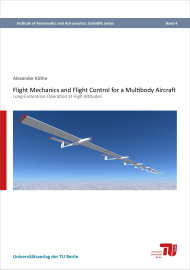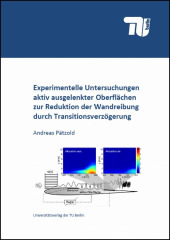Flight mechanics and flight control for a multibody aircraft
Long-endurance operation at high altitudes

Format: 14,8 x 21,0 cm
Publishing year: 2019
ircraft operating as so-called High Altitude Platform Systems (HAPS) have been considered as a complementary technology to satellites since several years. These aircraft can be used for similar communication and monitoring tasks while operating at a fraction of the cost. Such concepts have been successfully tested. Those include the AeroVironment Helios and the Airbus Zephyr, with an endurance of nearly 624 hours (26 days). All these HAPS aircraft have a high-aspect-ratio wing using lightweight construction. In gusty atmosphere, this results in high bending moments and high structural loads, which can lead to overloads. Aircraft crashes, for example from Google’s Solara 50 or Facebook’s Aquila give proof of that fact. Especially in the troposphere, where the active weather takes place, gust loads occur, which can lead to the destruction of the structure. The Airbus Zephyr, the only HAPS aircraft without flight accidents, provides only a very small payload. Thus it does not fully comply with the requirements for future HAPS aircraft.
To overcome the shortcomings of such single-wing aircraft, so-called multibody aircraft are considered to be an alternative. The concept assumes multiple aircraft connected to each other at their wingtips. It goes back to the German engineer Dr. Vogt. In the United States, shortly after the end of World War II, he experimented with the coupling of manned aircraft. This resulted in a high-aspect-ratio wing for the aircraft formation. The range of the formation could be increased correspondingly. The engineer Geoffrey S. Sommer took up Vogt’s idea and patented an aircraft configuration consisting of several unmanned aerial vehicles coupled at their wingtips. However, the patent does not provide any insight into the flight performance, the flight mechanical modeling or the control of such an aircraft. Single publications exist that deal with the performance of coupled aircraft. A profound, complete analysis, however, is missing so far.
This is where the present work starts. For the first time, a flying vehicle based on the concept of the multibody aircraft will be analyzed in terms of flight mechanics and flight control. In a performance analysis, the aircraft concept is analyzed in detail and the benefits in terms of bending moments and flight performance are clearly highlighted. Limits for operation in flight are shown considering aerodynamic optimal points. The joints at the wingtips allow a roll and pitch motion of the individual aircraft. This results in additional degrees of freedom for the design through the implementation of different relative pitch and bank angles. For example, using individual pitch angles for individual aircraft further decreases the induced drag and increases flight performance. Because the lift is distributed symmetrically, but not homogenously along the wingspan, a lateral trim of the individual aircraft in formation flight becomes necessary. The thesis presents a new method to implement this trim by moving the battery mass along half the wingspan, which avoids additional parasite drag.
Further, a complete flight dynamics model is provided and analyzed for aircraft that are mechanically connected at their wingtips. To study this model in detail, a hypothetical torsional and bending spring between the aircraft is introduced. If the spring constants are very high, the flight dynamics model has properties similar to those of an elastic aircraft. Rigid-body and formation eigenmotions can be clearly distinguished. If the spring constants are reduced towards zero, which represents the case of the multibody aircraft, classical flight mechanics eigenmotions and modes resulting from the additional degrees of freedom are coupled. This affects the eigenstructure of the aircraft. Hence, normal motions with respect to the inertial space as known from a rigid aircraft cannot be observed anymore. The plant also reveals unstable behavior.
Using the non-linear flight dynamics model, flight controllers are designed to stabilize the plant and provide the aircraft with an eigenstructure similar to conventional aircraft. Different controller design methods are used. The flight controller shall further maintain a determined shape of the flight formation, it shall control flight, bank and pitch angles, and it shall suppress disturbances. Flight control theories in the time domain (Eigenstructure assignment) and in the frequency domain (H-infinity loop-shaping) are considered. The resulting inner-control loops yield a multibody aircraft behavior that is similar to the one of a rigid aircraft. For the outer-control loops, classical autopilot concepts are applied. Overall, the flight trajectory of the multibody aircraft above ground is controlled and, thus, an actual operation as HAPS is possible. In the last step, the flight controller is successfully validated in non-linear simulations with complete flight dynamics.



